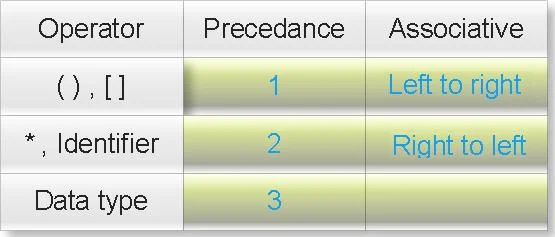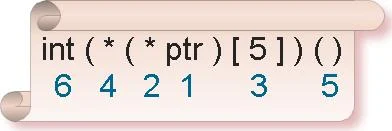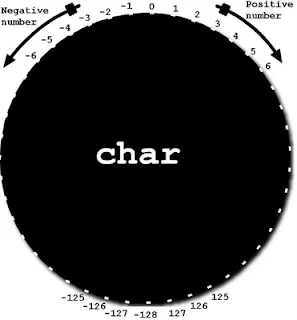1
What is pointer to a function?
Explanation:
(1) What will be output if you will execute following code?
int * function();
int main(){
auto int *x;
int *(*ptr)();
ptr=&function;
x=(*ptr)();
printf("%d",*x);
}
int *function(){
static int a=10;
return &a;
}
Output: 10
Explanation: Here function is function whose parameter is void data type and return type is pointer to int data type.
x=(*ptr)()
=> x=(*&functyion)() //ptr=&function
=> x=function() //From rule *&p=p
=> x=&a
So, *x = *&a = a =10
(2) What will be output if you will execute following code?
int find(char);
int(*function())(char);
int main(){
int x;
int(*ptr)(char);
ptr=function();
x=(*ptr)('A');
printf("%d",x);
return 0;
}
int find(char c){
return c;
}
int(*function())(char){
return find;
}
Output: 65
Explanation: Here function whose name is function which passing void data type and returning another function whose parameter is char data type and return type is int data type.
x=(*ptr)(‘A’)
=> x= (*function ()) (‘A’) //ptr=function ()
//&find=function () i.e. return type of function ()
=> x= (* &find) (‘A’)
=> x= find (‘A’) //From rule*&p=p
=> x= 65
(3) What will be output if you will execute following code?
char * call(int *,float *);
int main(){
char *string;
int a=2;
float b=2.0l;
char *(*ptr)(int*,float *);
ptr=&call;
string=(*ptr)(&a,&b);
printf("%s",string);
return 0;
}
char *call(int *i,float *j){
static char *str="godblessgovind.blogspot.in";
str=str+*i+(int)(*j);
return str;
}
Output: inter.blogspot.in
Explanation: Here call is function whose return type is pointer to character and one parameter is pointer to int data type and second parameter is pointer to float data type and ptr is pointer to such function.
str= str+*i+ (int) (*j)
=”godblessgovind.blogspot.in” + *&a+ (int) (*&b)
//i=&a, j=&b
=”godblessgovind.blogspot.in” + a+ (int) (b)
=”godblessgovind.blogspot.in” +2 + (int) (2.0)
=”godblessgovind.blogspot.in” +4
=”inter.blogspot.in”
(4) What will be output if you will execute following code?
char far * display(char far*);
int main(){
char far* string="godblessgovind.blogspot.in";
char far *(*ptr)(char far *);
ptr=&display;
string=(*ptr)(string);
printf("%s",string);
}
char far *display(char far * str){
char far * temp=str;
temp=temp+13;
*temp='\0';
return str;
}
Output: cquestionbak
Explanation: Here display is function whose parameter is pointer to character and return type is also pointer to character and ptr is its pointer.
temp is char pointer
temp=temp+13
temp=’\0’
Above two lines replaces first dot character by null character of string of variable string i.e.
"godblessgovind.blogspot.in"
As we know %s print the character of stream up to null character.
Explanation:
struct ABC{
int a;
float b;
char c;
};
int main(){
struct ABC *ptr=(struct ABC *)0;
ptr++;
printf("Size of structure is: %d",*ptr);
return 0;
}
Explanation:
Literal meaning of NULL pointer is a pointer which is pointing to nothing. NULL pointer points the base address of segment.
Examples of NULL pointer:
1. int *ptr=(char *)0;
2. float *ptr=(float *)0;
3. char *ptr=(char *)0;
4. double *ptr=(double *)0;
5. char *ptr=’\0’;
6. int *ptr=NULL;
What is meaning of NULL?
Answer:
NULL is macro constant which has been defined in the heard file stdio.h, alloc.h, mem.h, stddef.h and stdlib.h as
#define NULL 0
Examples:
(1)What will be output of following c program?
#include "stdio.h"
int main(){
if(!NULL)
printf("I know preprocessor");
else
printf("I don't know preprocessor");
}
Output: I know preprocessor
Explanation:
!NULL = !0 = 1
In if condition any non zero number mean true.
(2)What will be output of following c program?
#include "stdio.h"
int main(){
int i;
static int count;
for(i=NULL;i<=5;){
count++;
i+=2;
}
printf("%d",count);
}
Output: 3
(3)What will be output of following c program?
#include "stdio.h"
int main(){
#ifndef NULL
#define NULL 5
#endif
printf("%d",NULL+sizeof(NULL));
}
Output: 2
Explanation:
NULL + sizeof(NULL)
=0 + sizeoof(0)
=0+2 //size of int data type is two byte.
We cannot copy anything in the NULL pointer.
Example:
(4)What will be output of following c program?
#include "string.h"
int main(){
char *str=NULL;
strcpy(str,"godblessgovind.blogspot.in");
printf("%s",str);
return 0;
}
Output: (null)
Explanation:
In c we can pass the parameters in a function in two different ways.
(a)Pass by value: In this approach we pass copy of actual variables in function as a parameter. Hence any modification on parameters inside the function will not reflect in the actual variable. For example:
#include<stdio.h>
int main(){
int a=5,b=10;
swap(a,b);
printf("%d %d",a,b);
return 0;
}
void swap(int a,int b){
int temp;
temp =a;
a=b;
b=temp;
}
Output: 5 10
(b)Pass by reference: In this approach we pass memory address actual variables in function as a parameter. Hence any modification on parameters inside the function will reflect in the actual variable. For example:
#incude<stdio.h>
int main(){
int a=5,b=10;
swap(&a,&b);
printf("%d %d",a,b);
return 0;
}
void swap(int *a,int *b){
int *temp;
*temp =*a;
*a=*b;
*b=*temp;
}
Output: 10 5
Explanation:
Size of any type of pointer in c is independent of data type which is pointer is pointing i.e. size of all type of pointer (near) in c is two byte either it is char pointer, double pointer, function pointer or null pointer. Void pointer is not exception of this rule and size of void pointer is also two byte.
Explanation:
An uninitialized pointer is a pointer which points unknown memory location while null pointer is pointer which points a null value or base address of segment. For example:
int *p; //Uninitialized pointer
int *q= (int *)0; //Null pointer
#include<stdio.h>
int *r=NULL; //Null pointer
What will be output of following c program?
#include<string.h>
#include<stdio.h>
int main(){
char *p; //Uninitialized pointer
char *q=NULL; //Null pointer;
strcpy(p,"cquestionbank");
strcpy(q,"cquestionbank");
printf("%s %s",p,q);
return 0;
}
Output: cquestionbank (null)
Explanation:
Rule 1. Assign the priority to the pointer declaration considering precedence and associative according to following table.
(): This operator behaves as bracket operator or function operator.
[]: This operator behaves as array subscription operator.
*: This operator behaves as pointer operator not as multiplication operator.
Identifier: It is not an operator but it is name of pointer variable. You will always find the first priority will be assigned to the name of pointer.
Data type: It is also not an operator. Data types also includes modifier (like signed int, long double etc.)
You will understand it better by examples:
(1) How to read following pointer?
char (* ptr)[3]
Answer:
Step 1: () and [] enjoys equal precedence. So rule of associative will decide the priority. Its associative is left to right so first priority goes to ().
Step 2: Inside the bracket * and ptr enjoy equal precedence. From rule of associative (right to left) first priority goes to ptr and second priority goes to *.
Step3: Assign third priority to [].
Step4: Since data type enjoys least priority so assign fourth priority to char.
Now read it following manner:
ptr is pointer to such one dimensional array of size three which content char type data.
(2) How to read following pointer?
float (* ptr)(int)
Answer:
Assign the priority considering precedence and associative.
Now read it following manner:
ptr is pointer to such function whose parameter is int type data and return type is float type data.
Rule 2: Assign the priority of each function parameter separately and read it also separately. Understand it through following example.
(3) How to read following pointer?
void (*ptr)(int (*)[2],int (*) void))
Answer:
Assign the priority considering rule of precedence and associative.
Now read it following manner:
ptr is pointer to such function which first parameter ispointer to one dimensional array of size two which contentint type data and second parameter is pointer to such function which parameter is void and return type is int data type and return type is void.
(4) How to read following pointer?
int ( * ( * ptr ) [ 5 ] ) ( )
Answer:
Assign the priority considering rule of precedence and associative.
Now read it following manner:
ptr is pointer to such array of size five which content are pointer to such function which parameter is void and return type is int type data.
(5) How to read following pointer?
double*(*(*ptr)(int))(double **,char c)
Answer:
Assign the priority considering rule of precedence and associative.
Now read it following manner:
ptr is pointer to function which parameter is int type data and return type is pointer to function which first parameter is pointer to pointer of double data type and second parameter is char type data type and return type ispointer to double data type.
(6) How to read following pointer?
unsigned **(*(*ptr)[8](char const *, ...)
Answer:
Assign the priority considering rule of precedence and associative.
Now read it following manner:
ptr is pointer to array of size eight and content of array is pointer to function which first parameter is pointer to character constant and second parameter is variable number of arguments and return type is pointer to pointer ofunsigned int data type.
Explanation:
1. pascal: In this style function name should (not necessary ) in the uppercase .First parameter of function call is passed to the first parameter of function definition and so on.
2. cdecl: In this style function name can be both in the upper case or lower case. First parameter of function call is passed to the last parameter of function definition. It is default parameter passing convention.
Examples:
1. What will be output of following program?
int main(){
static int a=25;
void cdecl conv1() ;
void pascal conv2();
conv1(a);
conv2(a);
return 0;;
}
void cdecl conv1(int a,int b)
{
printf("%d %d",a,b);
}
void pascal conv2(int a,int b)
{
printf("\n%d %d",a,b);
}
Output: 25 0
0 25
(2) What will be output of following program?
void cdecl fun1(int,int);
void pascal fun2(int,int);
int main(){
int a=5,b=5;
fun1(a,++a);
fun2(b,++b);
return 0;
}
void cdecl fun1(int p,int q){
printf("cdecl: %d %d \n",p,q);
}
void pascal fun2(int p,int q){
printf("pascal: %d %d",p,q);
}
Output:
cdecl: 6 6
pascal: 5 6
(3) What will be output of following program?
void cdecl fun1(int,int);
void pascal fun2(int,int);
int main(){
int a=5,b=5;
fun1(a,++a);
fun2(b,++b);
return 0;
}
void cdecl fun1(int p,int q){
printf("cdecl: %d %d \n",p,q);
}
void pascal fun2(int p,int q){
printf("pascal: %d %d",p,q);
}
Output:
cdecl: 6 6
pascal: 5 6
(4) What will be output of following program?
void convention(int,int,int);
int main(){
int a=5;
convention(a,++a,a++);
return 0;
}
void convention(int p,int q,int r){
printf("%d %d %d",p,q,r);
}
Output: 7 7 5
(5) What will be output of following program?
void pascal convention(int,int,int);
int main(){
int a=5;
convention(a,++a,a++);
return 0;}
void pascal convention(int p,int q,int r){
printf("%d %d %d",p,q,r);
}
Output: 5 6 6
(6) What will be output of following program?
void pascal convention(int,int);
int main(){
int a=1;
convention(a,++a);
return 0;
}
void pascal convention(int a,int b){
printf("%d %d",a,b);
}
Output: 1 2
(7) What will be output of following program?
void convention(int,int);
int main(){
int a=1;
convention(a,++a);
return 0;}
void convention(int a,int b){
printf("%d %d",a,b);
}
Output: 2 2
Explanation:
The pointer which can point or access whole the residence memory of RAM i.e. which can access all 16 segments is known as far pointer.
Size of far pointer is 4 byte or 32 bit. Examples:
(1) What will be output of following c program?
int main(){
int x=10;
int far *ptr;
ptr=&x;
printf("%d",sizeof ptr);
return 0;
}
Output: 4
(2)What will be output of following c program?
int main(){
int far *near*ptr;
printf("%d %d",sizeof(ptr) ,sizeof(*ptr));
return 0;
}
Output: 4 2
Explanation: ptr is far pointer while *ptr is near pointer.
(3)What will be output of following c program?
int main(){
int far *p,far *q;
printf("%d %d",sizeof(p) ,sizeof(q));
}
Output: 4 4
First 16 bit stores: Segment number
Next 16 bit stores: Offset address
Example:
int main(){
int x=100;
int far *ptr;
ptr=&x;
printf("%Fp",ptr);
return 0;
}
Output: 8FD8:FFF4
Here 8FD8 is segment address and FFF4 is offset address in hexadecimal number format.
Note: %Fp is used for print offset and segment address of pointer in printf function in hexadecimal number format.
In the header file dos.h there are three macro functions to get the offset address and segment address from far pointer and vice versa.
1. FP_OFF(): To get offset address from far address.
2. FP_SEG(): To get segment address from far address.
3. MK_FP(): To make far address from segment and offset address.
Examples:
(1)What will be output of following c program?
#include "dos.h"
int main(){
int i=25;
int far*ptr=&i;
printf("%X %X",FP_SEG(ptr),FP_OFF(ptr));
}
Output: Any segment and offset address in hexadecimal number format respectively.
(2)What will be output of following c program?
#include "dos.h"
int main(){
int i=25;
int far*ptr=&i;
unsigned int s,o;
s=FP_SEG(ptr);
o=FP_OFF(ptr);
printf("%Fp",MK_FP(s,o));
return 0;
}
Output: 8FD9:FFF4 (Assume)
Note: We cannot guess what will be offset address; segment address and far address of any far pointer .These address are decided by operating system.
Limitation of far pointer:
We cannot change or modify the segment address of given far address by applying any arithmetic operation on it. That is by using arithmetic operator we cannot jump from one segment to other segment. If you will increment the far address beyond the maximum value of its offset address instead of incrementing segment address it will repeat its offset address in cyclic order.
Example:
(q)What will be output of following c program?
int main(){
int i;
char far *ptr=(char *)0xB800FFFA;
for(i=0;i<=10;i++){
printf("%Fp \n",ptr);
ptr++;
}
return 0;
}
Output:
B800:FFFA
B800:FFFB
B800:FFFC
B800:FFFD
B800:FFFE
B800:FFFF
B800:0000
B800:0001
B800:0002
B800:0003
B800:0004
This property of far pointer is called cyclic nature of far pointer within same segment.
Important points about far pointer:
1. Far pointer compares both offset address and segment address with relational operators.
Examples:
(1)What will be output of following c program?
int main(){
int far *p=(int *)0X70230000;
int far *q=(int *)0XB0210000;
if(p==q)
printf("Both pointers are equal");
else
printf("Both pointers are not equal");
return 0;
}
Output: Both pointers are not equal
(2)What will be output of following c program?
int main(){
int far *p=(int *)0X70230000;
int far *q=(int *)0XB0210000;
int near *x,near*y;
x=(int near *)p;
y=(int near *)q;
if(x==y)
printf("Both pointer are equal");
else
printf("Both pointer are not equal");
return 0;
}
Output: Both pointers are equal
2. Far pointer doesn’t normalize.
Explanation:
#include<stdio.h>
int main(){
signed char c1=130;
signed char c2=-130;
printf("%d %d",c1,c2);
return 0;
}
Output: -126 126 (why?)
This situation is known as overflow of signed char.
Range of unsigned char is -128 to 127. If we will assign a value greater than 127 then value of variable will be changed to a value if we will move clockwise direction as shown in the figure according to number. If we will assign a number which is less than -128 then we have to move in anti-clockwise direction.












No comments:
Post a Comment